The weather was so miserable that I wondered if anyone would show up for the tour. But people arrived, a few at a time, and soon a group of hard core tree lovers, history buffs and woodworkers had gathered under the shelter of the cottage’s front porch. Councillor Mary-Margaret McMahon (Ward 32 Beaches-East York) and Michael Finkelstein (Eco-Woodturner) started by discussing the Maple Leaf Forever tree, which is said to have inspired the song that was once Canada’s unofficial national anthem.
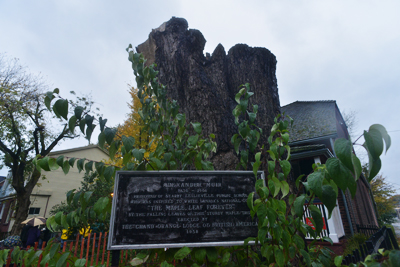
A storm brought the tree down this past July, but that’s not the end of its story. Artists and woodworkers will create art pieces and cultural items to be donated to venues such as the Royal Ontario Museum and the City Clerk’s office. Rob McMonagle, from the City’s Economic Development and Culture Division, shared some details about the process of salvaging this wood and storing it for future use.
Councillor McMahon told us about the political process of saving the wood from the chipper. She also explained that the snag, or remaining trunk, will be left to see if it regrows. As silver maples often do re-sprout, it is possible that this maple tree really will live forever (or at least a while longer)!
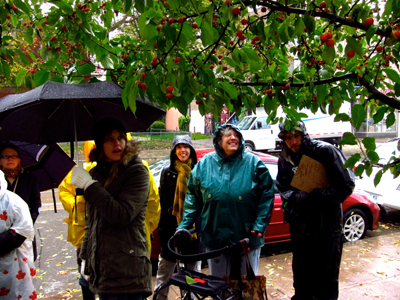
We explored a number of trees in the area for their wood utilization potential, and stopped at a crab apple loaded with fruit in a front yard. Michael explained how he might use the wood from this tree when it reaches the end of its life, and discussed the way he looks for the crotches - where two branches meet - for interesting natural features to play up. In addition to looking beautiful, fruit wood is also aromatic – which can make anyone working with it hungry!
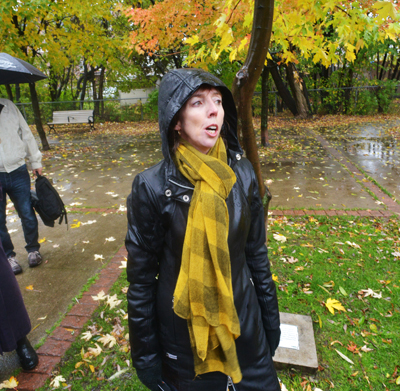
A sapling, an offspring of the Maple Leaf Forever tree, grows in Maple Leaf Forever Park. Back in 2000, nearby resident Bill Wrigley realized that the Maple Leaf Forever Tree might be nearing the end of its life, and planted some of its seeds in his backyard. Tour participant Mary-Fran had interviewed Mr. Wrigley in the past and was able to share more information about the young offspring. Only one of the many seedlings Bill planted survived, and by 2007 it had grown too big for his yard so was transplanted here in the park. With the strong genetic characteristics of its famous parent, we can expect this young tree to live a long time. Through it, the Maple Leaf Forever Tree will live on.
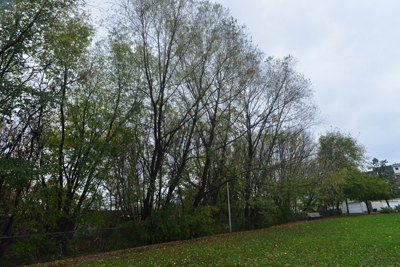
Next we discussed a row of willows lining the south side of the park. Willows can be used in a very different way from the maples we’d been discussing – they’re great for weaving. The branches are very flexible and can be woven into baskets and fences. The presence of willows here indicates that the ground is fairly wet, since willows like a lot of water. In fact, Ashbridges Bay used to reach all the way up to this approximate location! Water-loving willows are extremely valuable for stormwater management – a mature specimen will intercept about 16,000 litres (4,000 gallons) of water per year!
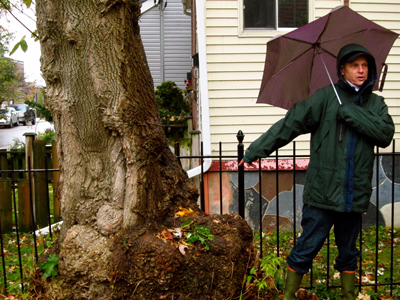
Back near the cottage, Michael pointed out an interesting Manitoba maple tree. Exhibiting the stubbornness that is characteristic of the species, this tree had grown around a fence. It had lots of burls and epicormic shoots – small suckers growing off the main trunk. For a woodworker like Michael, this is pretty exciting – he would expect to find some interesting grain patterns to work with from this tree. What others might consider defects, Michael sees as the basis of his art.
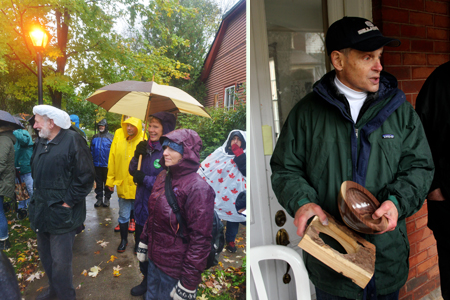
Michael concluded the tour by showing some of the beautiful things that he has made from wood salvaged around Toronto. He even demonstrated how he cuts a bowl from a chunk of bare wood. By the end of the tour, everyone had learned a lot, but we were all ready for a hot cup of tea!
Our Tree Tours are supported by Ontario Power Generation's Biodiversity Program, York Region and the Ontario Trillium Foundation. This Tree Tour was also supported by the City of Toronto’s Economic Development and Culture Division. If you’d like to learn more about wood utilization in Toronto, check out the newest section of LEAF’s website, dedicated to the issue of urban wood utilization.
